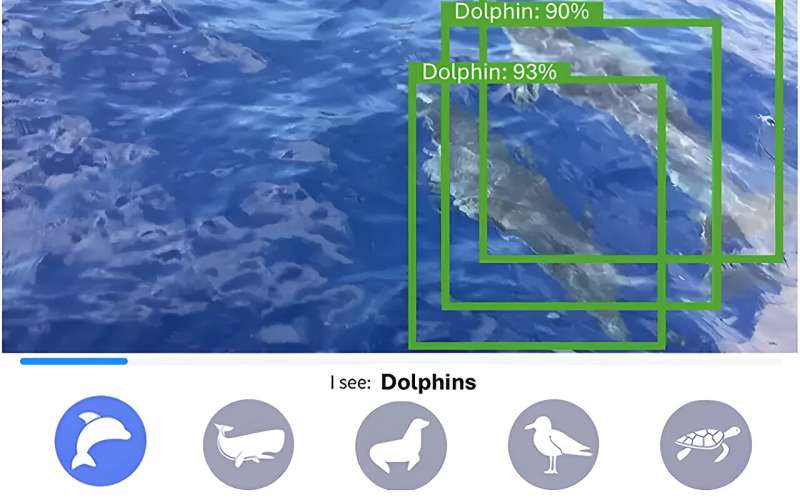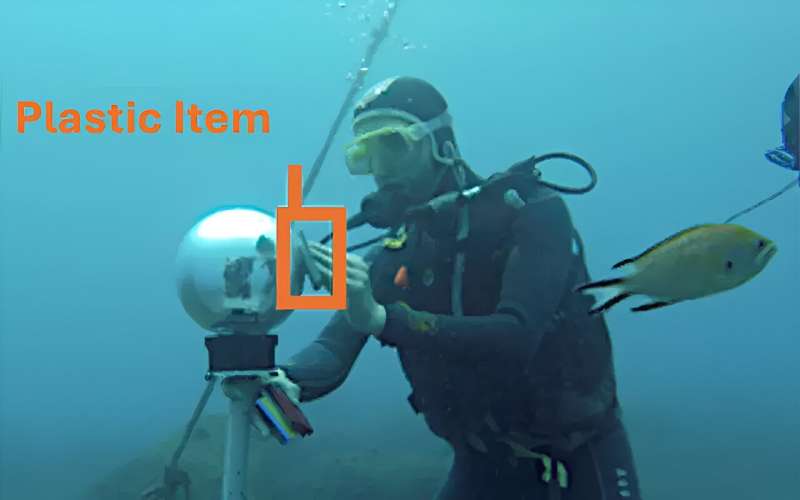This article has been reviewed according to Science X's editorial process and policies. Editors have highlighted the following attributes while ensuring the content's credibility:
fact-checked
trusted source
proofread
AI making waves in marine data collection

Numerous measurement stations around the world provide us with data about air quality, allowing us to enhance it. Although we are increasingly collecting data from marine areas, access to such data is considerably more challenging. Signals are poorly transmitted through water, differences in both pressure and currents hinder measurement devices and there is an absence of pre-constructed computing infrastructure.
Could intelligent technologies help us improve marine data collection? Professor of Computer Science Petteri Nurmi and his research group at the University of Helsinki have joined forces with researchers at the University of Tartu, University of Madeira, and MARE-Madeira, ARDITI, a non-profit marine research institute, to develop solutions combining sensor technologies and embedded Artificial Intelligence.
The researchers strive to make more efficient and expansive the data collection methods now used in, for example, environmental research.
"The higher the quantity and quality of data about the oceans obtained, the better we can use it to understand and protect the oceans. Our methods help expand the total amount of data gathered from marine areas and reduce the effort required to collect and analyze them," Nurmi says.
AI identifies animal species
In a recently published study, Nurmi and his colleagues used data collected from whale-watching excursions in Madeira, Portugal. The vessels used for these excursions usually carry persons who can record observations of the species seen or video the environment during the tour.

In the study, an AI model assisted individuals in environmental real-time observation. AI was also used to identify whether the video footage showed certain animals, such as dolphins or whales. In addition, the researchers compared the AI assistance received by experienced and less experienced observers and explored how AI-assisted animal observations served as data for training the model.
"We analyzed how AI assistance affected the quality of data and human observations. AI improved the accuracy of animal observations by amateurs, but had no effect on expert observations. On the other hand, when the data collected were used for training purposes, the best results were achieved by combining AI classifications with expert observations. Thus, interactions between humans and AI can influence each other, and they need to be better understood," Nurmi explains.
The method could ideally be used for faster identification of animals moving in marine areas. The results and methods can also be expanded to observe other organisms.
Identifying marine plastics
Another recent study focused on identifying and classifying underwater plastic debris. These differ from microplastics, or tiny plastic particles, in being visible to the naked eye. One method currently used to obtain information on marine plastic pollution is to have divers or devices collect samples for laboratory analysis, but this usually takes a great deal of time. Surface-layer plastics can be observed with aerial photography as well.
The researchers developed an AI model functioning with sensors based on the analysis of light spectrum data. The model could be connected to diver equipment or a diving robot to determine the type of plastic waste underwater. The researchers discovered that the model was able to distinguish types of plastic with 85% accuracy.

"We are capable of identifying four out of five objects directly, which means we need to send fewer samples to a lab for identification. This provides us with more data and thus a more comprehensive overview of marine plastic pollution."
Nurmi emphasizes that his and his colleagues' aim is to create new ways of collecting data. Experts in other fields can then come up with the best uses for the new methods. For instance, once the type of plastic is known, it is easier to find out its source and consider ways of preventing pollution. The data also help researchers understand the effects on ecosystems of different types of plastic, as they contain different chemicals and break down in different ways.
Better data for better protection
Nurmi believes that the situation with marine data may be similar to the one in air quality research years ago.
"Originally, air quality research relied on a few large measuring towers, but now you can find them even on bus stops. In marine sciences, this is not yet the case, even if the methods for collecting marine data and the number of actors involved are increasing. Our research ensures that we can obtain an even greater amount of even more accurate marine measurement data as the capabilities to collect data improve."
In the future, the use of underwater drones, smart buoys, vessels and coastal base stations is likely to increase in marine data collection. The expanding network of such tools will offer further ways to gather underwater data.
"Despite their vital importance for humanity, marine protection and regulation, unfortunately, tend to be drowned out by other issues. The higher the quantity and quality of marine data collected, the better we are able to develop solutions and regulations improving the status of the marine environment."
More information: Paper I: Man and the Machine: Effects of AI-assisted Human Labeling on Interactive Annotation of Real-Time Video Streams
Paper II: SEAGULL: Low-Cost Pervasive Sensing for Monitoring and Analysing Underwater Plastics
Provided by University of Helsinki




















